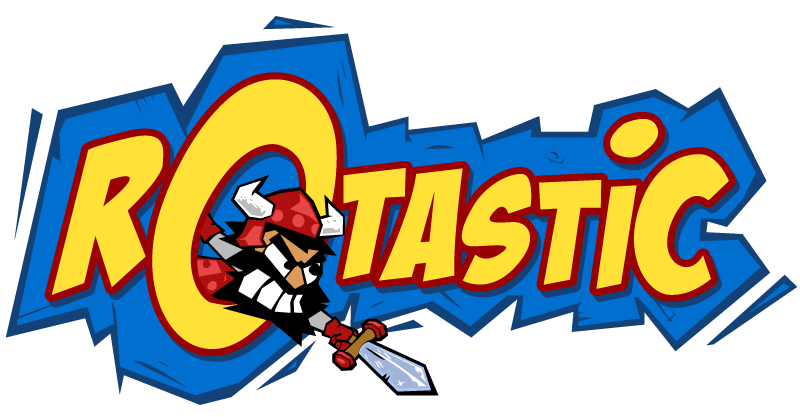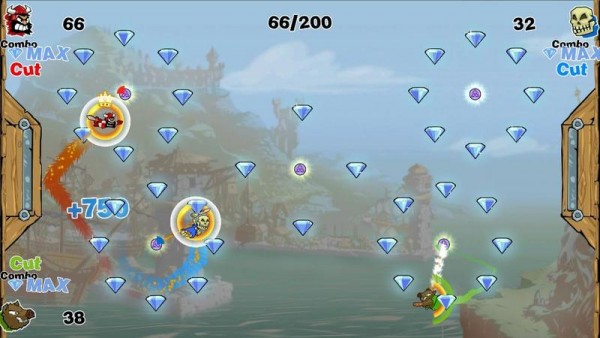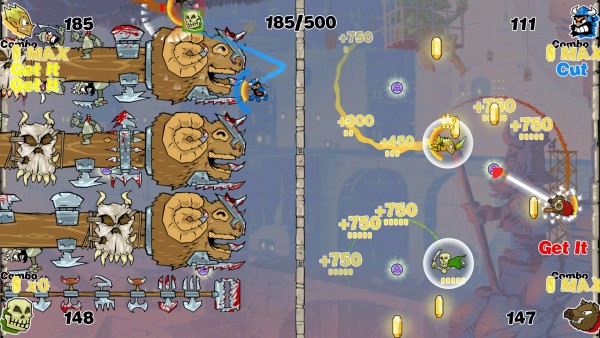Rotastic is really easy to like at first. It’s a simple puzzle game with a unique gameplay hook and a charming—though at this point generic—cartoony art style. But it doesn’t take long to realize Rotastic is boring you to tears. The one single mechanic that makes the game unique among a myriad of other indie puzzle games with a cartoony art style ends up being its most damning problem.
Rotastic builds its entire foundation upon its unique, and only, mechanic. The game is played by swinging from a set number of hook points on a stage, making sure not fall out of the level. You can either swing or change your direction while swinging, and that’s it. Levels are organized into worlds, with 9-10 stages in each world. The average objective in a stage ranges from jewel-collecting to brick-breaking in a set amount of time, with the degree of your success judged upon how long it took you and how many lives you lost.
Stages have a nice variation, but they definitely begin to repeat from world to world. While most stages are merely tweaks upon jewel-collecting or brick-breaking, there are duel stages that pit you against other AI opponents. In those cases you must strategically swing in a way that will cut other enemies’ ropes and make them fall to their death. But while Rotastic’s stages are fun and varied, it’s mostly rendered moot by the lack of evolution and polish in the game’s swinging mechanics. The stage might change around you, but it never becomes more interesting or fun to swing around. I played through the game constantly seeing opportunities for the gameplay to improve. The simple addition of upgrades could have completely changed the game. What if I could buy the ability to climb and retract my rope to fine-tune my swings? What if there was an ability that makes aiming and transitioning hook points easier? It seemed so obvious to include some sort of progression mechanic, or anything to mix up the monotony and difficulty of swinging, but there just isn’t.
In addition to campaign levels, you’ll find Combat Mode—which essentially lets you form custom games with AI opponents or local play. This is pretty much what you would expect—you can set a match to your liking in the settings, but it’s nothing exciting or interesting. And other than that, you can go check out the leaderboards, which in a week after the game’s release has only a little more than 200 entries on it.
Rotastic features a nice visual style, focusing on medieval times with a cartoony twist. The game even tries to set up small back stories for the four characters you can choose from on their website, even though all of them play exactly the same in practice. And the music, while limited, gives off a light-hearted vibe that fits the overall style.
VERDICT:
You can taste the unfulfilled potential in Rotastic. While there is fun to be had, swinging feels unnecessarily difficult and takes far too long to get the hang of. But for the low price of $10, you could definitely do worse. Rotastic can still be plenty fun to play in small chunks, and really feels the type of game that would benefit from coming to Vita. It’s a very simple and charming puzzle game that could be so much better, but is still pretty good as is. If you’re into competitive games you can play with your family, then you should definitely give Rotastic a chance.







More Stories
Full Tracklist Revealed for Just Dance 2017
WWE 2K17 Trailer Focuses on Basic Controls
Minecraft Story Mode -The Complete Adventure- Coming to Retail October 25th